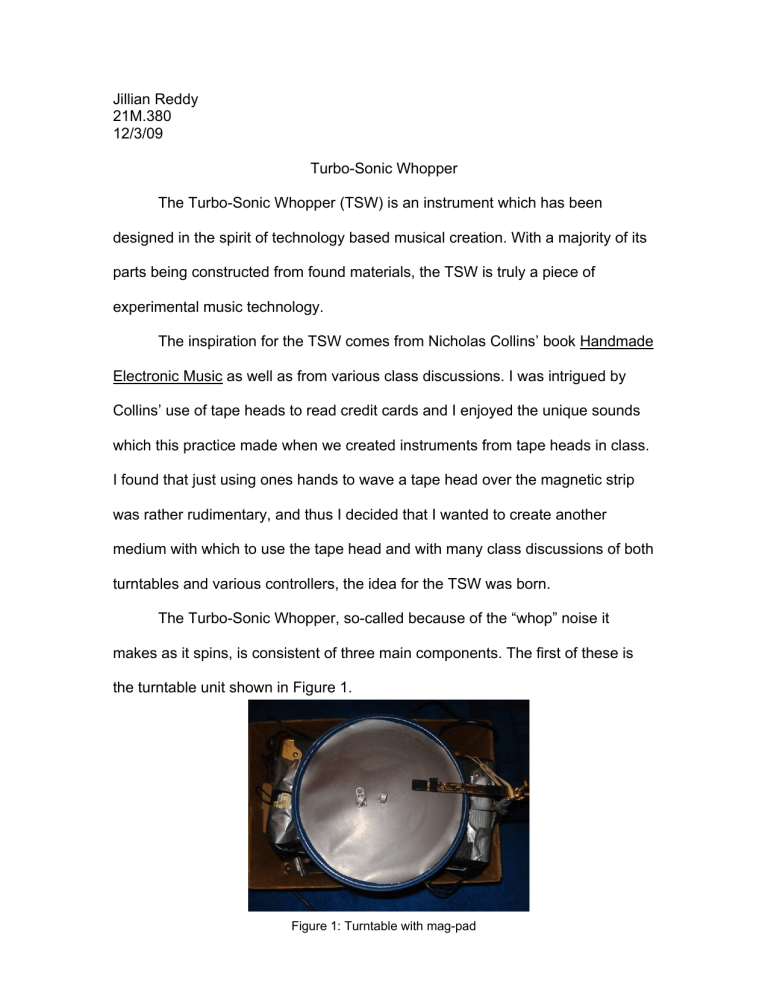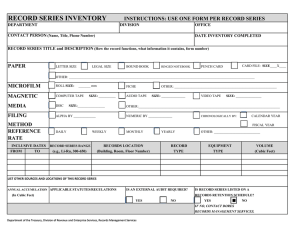Jillian Reddy 21M.380 12/3/09

Jillian Reddy
21M.380
12/3/09
Turbo-Sonic Whopper
The Turbo-Sonic Whopper (TSW) is an instrument which has been designed in the spirit of technology based musical creation. With a majority of its parts being constructed from found materials, the TSW is truly a piece of experimental music technology.
The inspiration for the TSW comes from Nicholas Collins’ book Handmade
Electronic Music as well as from various class discussions. I was intrigued by
Collins’ use of tape heads to read credit cards and I enjoyed the unique sounds which this practice made when we created instruments from tape heads in class.
I found that just using ones hands to wave a tape head over the magnetic strip was rather rudimentary, and thus I decided that I wanted to create another medium with which to use the tape head and with many class discussions of both turntables and various controllers, the idea for the TSW was born.
The Turbo-Sonic Whopper, so-called because of the “whop” noise it makes as it spins, is consistent of three main components. The first of these is the turntable unit shown in Figure 1.
Figure 1: Turntable with mag-pad
The turntable itself is made of metal popcorn container lid with a large magnetic pad (Mag-pad) attached to its top. The platter’s rotation is driven by a small battery powered motor which was pilfered from a K’Nex toy set and is controlled by an on/off switch affixed to the unit. The second main component of the TSW is the tape head arm (Figure 2). This arm supports the tape head (Figure 3) which in turn “reads” the magnetic turntable pad as it spins. Similarly to a conventional turntable, the arm has the ability to read one section of the disc by being held in place with a rubber band. The magnetic tape head is a stereo head attached to a set of coaxial cables which plug into the auxiliary jack of the third component, a
Fender guitar amplifier shown in Figure 4.
Figure 2: The tape head arm configuration. The arm consists of an appendage to support the tape head on the left and a handle with which to play the TSW on the right
Figure 3: Close-up of the magnetic tape head.
Figure 4: The amplifier. Note that the yellow and red coaxial cables lead directly from the tape head into the amp.
To play the Turbo-Sonic Whopper, the user must first plug in and turn on the amplifier. Secondly, the turntable must be started spinning by placing the switch in the “on” position. The tape head will begin to pick up signals from the magnetic field of the mag-pad and these will be sent to the amplifier which will raise the signals to an audible volume. Unlike the credit cards which were
“played” in class, the mag-pad is not encoded with data, and thus it has a uniform signal across its entirety. Therefore, when the tape head arm is stationary, a relatively steady tone is emitted from the amplifier. The user can change tones by using the arm handle to rotate the arm to read the mag-pad at different diameters. Since the outer edge of the mag-pad is rotating more quickly than the center, the sounds emitted from this region are of a higher pitch. In addition, as the tape head moves vertically away from the mag-pad, the signal it receives is weaker and thus is of softer volume. Therefore, the user can modify dynamics by moving the arm up and down.
The TSW is, in a historical context, the combination of magnetic tape technology and turntablism. Much in the same way that turntablists can scratch a record by moving it with their hand, the TSW produces a scratch-like sound when the arm is moved allowing for the user to play the instrument in a similar fashion to the way one would play a turntable.
The sound produced by the TSW is quite versatile. The instrument has the ability to play a wide range of tones which are melodic to the ear. However despite the sound quality of the device, there are a few areas which could be improved. First of all, the system would benefit from a mechanism designed to
change the speed of the motor. This would allow for an even greater range of pitches and thus more musical possibility. Furthermore, the motor could be outfitted with a break device such that turning the power off would not only stop current to the motor, but also stop the plate from spinning. Also, there is great room for experimentation with different magnetic objects being placed on the platter. For instance, credit cards could be used, although this may be difficult considering the linearity of their magnetic strips. Perhaps, a disc laminated with cassette tape could be created which would be another interesting musical feature.
The Turbo-Sonic Whopper is a prime blend of old and new technology. It presents various channels through which the user can undertake musical experimentation. The TSW presents a new controller for an old medium and thus it is a great example of the progress of music technology.
Works Cited
Collins, Nicholas. Handmade Electronic Music.
2 nd ed. Routledge. Print.
MIT OpenCourseWare http://ocw.mit.edu
21M.380 Music and Technology (Contemporary History and Aesthetics)
Fall 2009
For information about citing these materials or our Terms of Use, visit: http://ocw.mit.edu/terms .




